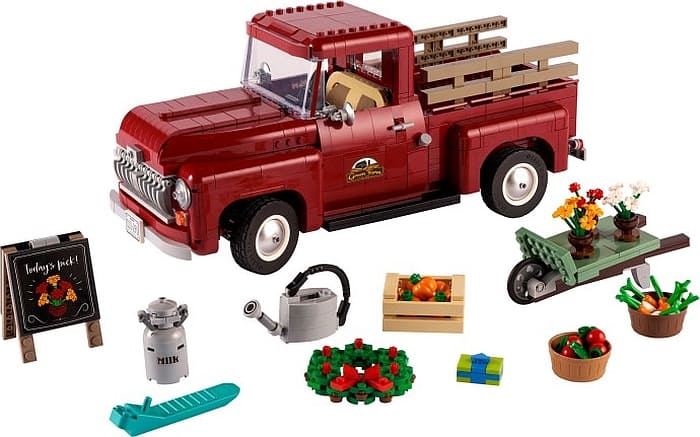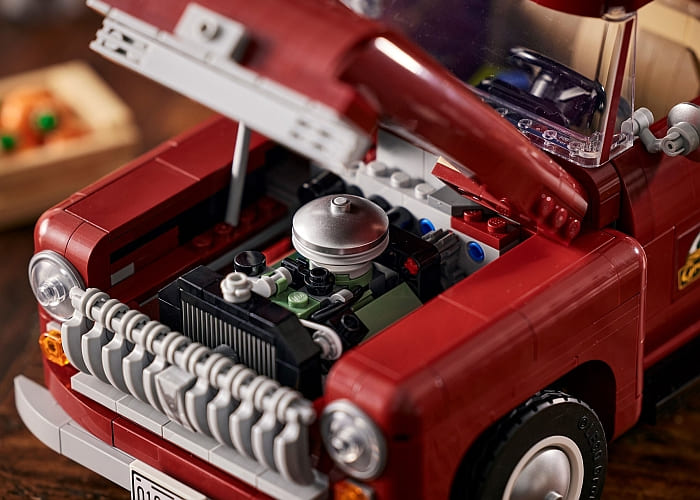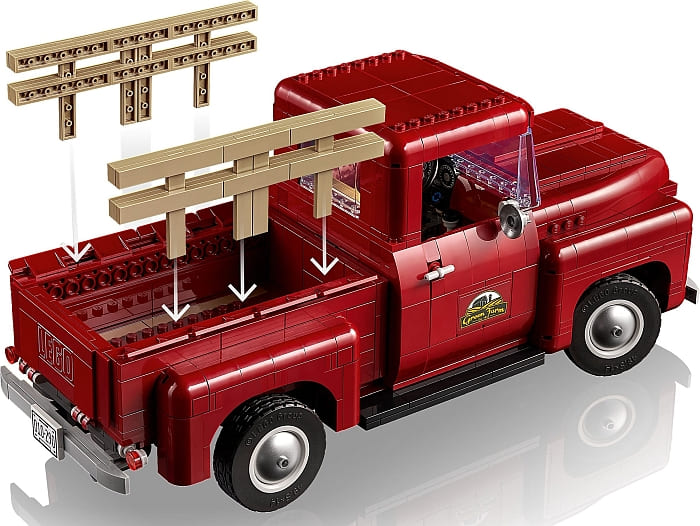(Written by William)
I never intended to get into the Creator Expert Vehicle line, but, once I did, I found myself in awe of the fantastic building experiences they offer. And I figured the #10290 LEGO Creator Expert Pickup Truck would be an excellent addition to my growing collection.

The odd thing is that this set is not named like all the other vehicle models. Apart from the #10258 LEGO Creator Expert London Bus, most of these large detailed vehicles say the exact vehicle that is being replicated. Turns out, there is a good reason for this, which we’ll get into.
Fortunately, despite this oddity, you can still expect to have an amazing time building the set. All the detail work is exquisite and the vehicle has the extra bits of functionality like working steering we like to see in models of this size. But the extra wow factor is all the accessories you build to go along with the truck. It is ready for any season. So, let’s dig into this model and see what’s what.
RE-CREATION VS. RE-INTERPRETATION
When you see a model with so much detail worked into its design, it has to be a scaled-down version of something from the real world, right? Well, it can be and many times the details of a model are based on something real. But it is not necessary to have a model strictly built on a specific thing. This truck is a great example of when it might be a better choice to build an interpretation of a thing rather than an exact replica.

It all comes down to the focus of your model. In other words, who do you want this to appeal to the most? If your answer is a car enthusiast, then you probably want to make a replica of a specific make, model, and year of a car. However, in this instance, the goal was to aim for general nostalgia.
Watching the designer-video for this model, a big portion deals with using the various accessories to decorate your truck for the right season. This is also why no particular make and model is mentioned. Rather, it is styled like a pickup truck from the 1950s. Using that as a basis for a tiny bit of research, I found a couple of similar trucks.

When it came to the rounded body styling, all the trucks featured similar curves. However, some of the F1 Ford trucks in the mid-1950s were a closer match. Though, if you open up the hood of the model, you will see a distinct dome shape in the engine. This is to simulate a hemispheric combustion chamber. And that V8 engine style was a staple of Chrysler’s trucks in the ’50s.
This blending of makes and models tends to help blur the lines for even the most diehard auto fans. It allows them to focus on elements that resonate with their favorite style of truck and disregard the parts that don’t match up. It is sort of like adding a filter to how we view things from the past.
Then the question remains, would it have been a better set if LEGO designers picked an exact make and model for the truck? I don’t think so. Rather, it might hurt the model in several ways. Those looking for a nice old-timey display-piece may not go for a model that is trying to advertise a very specific truck. It would subconsciously convey to people that they need to be familiar with a specific vehicle to enjoy the model version.
On the other end of the spectrum, for hardcore vehicle fans, it would have presented a different issue. Many times, a vehicle fan can appreciate all types of models. However, there will be brands they are more loyal to and more passionate about. Someone into Ford trucks may completely ignore a Chrysler truck and vice versa for no other reason than the brand name. Take that distinction away and have a model that blends features together and now you have something both fan bases can appreciate.
I think the important point is, that no matter what your focus is, you can still build a highly detailed and enjoyable model. Additionally, if you are a stickler for having specific makes and models, this set makes an excellent jumping point for your own modifications.
MINIMAL STUDS FOR LARGE MODULAR SECTIONS
This is a technique I’ve been wanting to touch on for quite some time now. I’ve been building fairly large LEGO sets lately, and I’ve noticed that if there is a section separate from the main model that later connects to it, they tend to have fewer studs. And I’m not talking about a modular section that is meant to be removed for play like with the various LEGO Modular Buildings. Rather, I’m referring to elements that are meant to be fixed in place.

The #10290 LEGO Creator Expert Pickup Truck gives us a clear example of this with the bed of the truck. Once the floor and three of the walls are built, you attach the assembly to the frame of the vehicle. For the most part, there are three 2×2-stud sections that the bed of the truck attaches into, but, for the most part, it rests on LEGO Technic lift-arms.
You would think this would make it structurally weaker than if the entire bed was connected solidly with the frame of the truck. However, the opposite is true. Using minimal studs actually makes the entire model more structurally sound. Sounds weird, doesn’t it?

It all has to do with two major elements. First, is the practicality of attaching too many studs together, and the second is an object’s given mass. Let’s start with the first reason since it transitions into the second.
When you have a lot of studs, it does provide a very good sticking surface. However, much more effort needs to go into making sure all the studs are properly seated. A good example of this is to take a baseplate and then try attaching a 16×16 plate to it. Generally, putting the plate on the baseplate and slightly pushing down won’t ensure that all the studs have properly connected. Most of the time, you’ll need to pick up both pieces and press them together multiple times in various spots to make sure they are pressed together.
If you fail to press all these studs together then you end up with gaps that can undermine the stability of the connection. Over time, pieces will naturally flex and compress given changes like temperature. However, if a gap already exists, you’re more likely going to see the elements simply detach from one another. All in all, it takes a lot more effort to connect more studs at the same time just to create a larger mass. This brings us to our second issue.
The more mass you have on a given object, the more strain the parts will be under. This strain builds up and becomes more pronounced as the mass increases. However, if you only use minimal connection points between two objects, they can be securely connected while at the same time not stressing out their own parts. This also makes it much easier for the maintenance of your model.
Say, you had the #10290 LEGO Creator Expert Pickup Truck for some months, you played around with it extensively, and some things got out of place. Instead of dismantling everything and rebuilding the model to repair it, you can simply check on the points where the large modular sections attach. In this case, pressing on the three major connection points of where the bed meets the frame of the truck.
Incorporating this technique into your own models is fairly easy. Any smooth or open surface can help reduce the number of studs you use. As for where studs should go, I suggest finding either the most extreme or central-most points of whatever you’re connecting on a given surface.
FINAL THOUGHTS
I like this set for two major purposes. First, it makes an excellent decorative piece. Throw in accessories for every season and you have a highly versatile model that still manages to look classic and iconic. You even have a choice to remove the sidewalls, which changes the look of the truck from farm to work in an instant.

The second reason is for the car fans. I got into the LEGO Creator Expert Vehicles with the #10220 LEGO Creator Expert Volkswagen T1 Camper Van and have picked up all the larger vehicles done since its release. Even though the #10290 LEGO Creator Expert Pickup Truck isn’t licensed, it easily fits in with the rest. The scale feels right, the level of detail is excellent, and we get a vehicle type we haven’t seen before. I, in fact, had a better time with this model than some of the simpler LEGO Creator Expert Vehicles I’ve built in the past.
If I had any concerns with this model it would have to be the dark-red coloring. Having built many sets over the years, I’ve noticed that any parts with dark-red coloring don’t hold up very well. Over the span of a decade, these parts do become brittle and have a tendency to break. Given the sheer amount of dark-red parts in this model, I am a bit concerned with how it will hold up years down the line. Most of the breakage I’ve seen has been with standard bricks, plates, and tiles, and given the fact that the majority of this model is slopes, this may not be an issue, but I’d feel remiss if I didn’t mention this.
With that said, you do get your money’s worth out of this one. It has many parts in new colors and delivers a fantastic build experience. Plus, I don’t think I’ll have people’s eyes glaze over when I show it off like with some of the vehicles with specific makes and models. In the video below, I summarize my thoughts and show off some of the highlights of this great set.
What do you think? How do you like the LEGO Creator Expert Pickup Truck? Do you have it already? And what do you think of the techniques we discussed here? Are there any other interesting features that you noticed? Feel free to share your thoughts and discuss in the comment section below!
And you might also like to check out the following related posts:












Keep on truckin’ your blues away.
Anyway, it’s not my type of set, as I’m not really a car fan, and my apartment is too cluttered for me to know where to put it, but it’s a pretty cool set, otherwise…
One of my favorite sets of the year. Question; did you notice any color differences between the dark red parts? In my experience, dark red tends to have a lot of different shades.
I love it! It’s unbranded and represents all classic trucks from the late 40’s and early 50’s. It is a nice set.
I like how they did the engine. And those claw pieces for the front grille. They should make more generic cars and trucks like this.
I just assumed Lego made this truck in response to the popularity of the 1953 Ford F-100 featured in the “Christmas in Evergreen” Hallmark movies. Many variations of this Christmas themed vintage red truck have become very popular Christmas decorations in the last few years.
I thought of that too.
Hmm, my impression is that Hallmark barely was a thing outside of North America. I don’t know if there ever was a local European version, so it seems a bit narrow.
Well, there’s still a market for 50’s Americana over here, so Lego might have counted on selling the set through that connection…
I really like the little wreath. I think we even have the pieces to make our own. Might make a few for our Christmas tree.
Seems like they redid dark red a while ago specifically to address issues with brittleness, so hopefully with this set having come out since then it won’t have those problems: https://www.newelementary.com/2019/05/has-lego-color-dark-red-changed.html
Yes, there shouldn’t be any issues with later models. And if you do run into more brittle parts, LEGO will replace them. 🙂